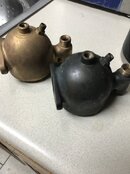Thanks for input. As for following what the manufacturers recommend, most manufacturers I am certified to service regulators say use GMC Ultrasonic Solution, and don’t dilute. Like I have stated multiple times, it 50-70% phosphoric acid, plus a surfactant. I am not pulling this from air, it’s per the MSDS. GMC Ultrasonic Solution is expensive, assuming you can find a dive shop to sell it, and the shipping is expensive.
Some people are using a diluted vinegar solution; so 5% acetic acid, and diluting even further. Dive shops use 50-70% phosphoric acid (GMC Ultrasonic Solution.)
Atomic says a 50/50 vinegar Solution or Blue Gold Solution. When I asked in the Atomic class, what is the concentration of acetic acid we should be using; 5% from the grocery store, or 99% from a chemical supplier. I was told, use the GMC Ultrasonic Solution. The look on his face was, I have no clue what you just asked.
Scubapro says GMC Ultrasonic Solution, because it’s the best at removing salt water deposits, and corrosion. Another regulator manufacturer (I don’t want to say brand) service class was a joke. They asked who has taken the Scubapro class, the folks that raised their hand was given a certificate of completion. They also said, I can’t teach you anything more than what Scubapro has taught you. Scubapro class was 3 days long, this manufacturers class was only a 1/2 day.
I like what Couv is saying because it’s more inline with the GMC Ultrasonic Solution. GMC Ultrasonic Solution works. Have you tried not diluting the phosphoric acid down so much?
I would like to use the GMC Ultrasonic Solution but need a good source.
Some people are using a diluted vinegar solution; so 5% acetic acid, and diluting even further. Dive shops use 50-70% phosphoric acid (GMC Ultrasonic Solution.)
Atomic says a 50/50 vinegar Solution or Blue Gold Solution. When I asked in the Atomic class, what is the concentration of acetic acid we should be using; 5% from the grocery store, or 99% from a chemical supplier. I was told, use the GMC Ultrasonic Solution. The look on his face was, I have no clue what you just asked.
Scubapro says GMC Ultrasonic Solution, because it’s the best at removing salt water deposits, and corrosion. Another regulator manufacturer (I don’t want to say brand) service class was a joke. They asked who has taken the Scubapro class, the folks that raised their hand was given a certificate of completion. They also said, I can’t teach you anything more than what Scubapro has taught you. Scubapro class was 3 days long, this manufacturers class was only a 1/2 day.
(I don't have any experience with Blue Gold.)
I've been using 8-10% phosphoric acid with just a little (same as above 1 teaspoon per quart) liquid soap (Dawn) for a few years now. It works just as well, if not better than 50/50 water vinegar and smells much better. I cannot say for sure, but it also seems to be less corrosive to chrome.
Here's a link to a vendor I've used:
950 ml of 85% Food Grade Phosphoric Acid | eBay
Here is a calculator as you probably won't be using it all at once.
Dilution Calculator - Molarity, Percent - PhysiologyWeb
I like what Couv is saying because it’s more inline with the GMC Ultrasonic Solution. GMC Ultrasonic Solution works. Have you tried not diluting the phosphoric acid down so much?
I would like to use the GMC Ultrasonic Solution but need a good source.





